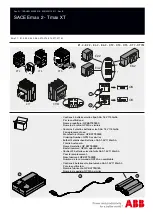
ECBU User Manual 1-16-19 Rev 1.0 Page
5
of
12
Analog Inputs
12 Analog inputs on the J1 connector can range from 0-28VDC, with a bandwidth of <100Hz. See Tables
1 and 2 below. The system response to the analog inputs is configured through the VeeConnect Display.
Discrete Inputs
12 Discrete Inputs on the J1 connector are configured as Open/Ground inputs, with OPEN being the
inactive state and GROUND being the active state. The system response to the discrete inputs is
configured through the VeeConnect Display.
Battery/Ignition Switch Input
The ECBU has an Ignition Switch Input which is intended to be driven high by the ignition aux power
tap. A 12V BUS voltage on this input will wake the ECBU up from low quiescent power mode. Turning
the ignition switch off shuts the ECBU system down.
Manual Interface
The ECBU Breaker has a manual interface on the enclosure consisting of:
•
A Manual Override Switch that is used to toggle each ECB channel ON and OFF by momentarily
pressing the membrane switch.
•
A green BREAKER ON indicator, indicating that an ECB is ON. This is a hardware indication, which
is controlled without the use of the system firmware.
•
A red TRIPPED LED, which indicates that an ECB is TRIPPED or otherwise disabled. This indication
IS generated and controlled by the system firmware.
•
Green INPUT POWER LED, which indicates that the ECBU is connected to battery power greater
than 5.2VDC.
•
Green NMEA STATUS LED, which indicates activity on the NMEA 2000 bus.
Digital Communications Interfaces
The system includes the following digital communications interfaces:
•
A USB port is provided for maintenance access, for updating the system firmware, for loading
configuration databases, and for saving configuration database. This port can also source up to
500mA for charging USB devices.
•
A NMEA 2000 port is provided to allow this system to communicate with the VeeConnect
Display.

























